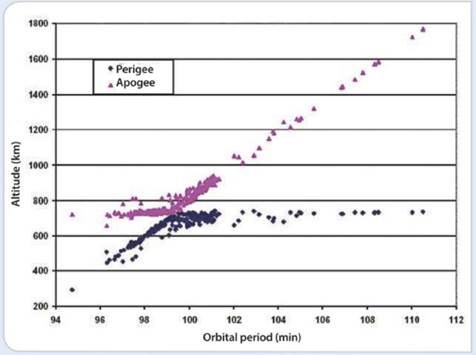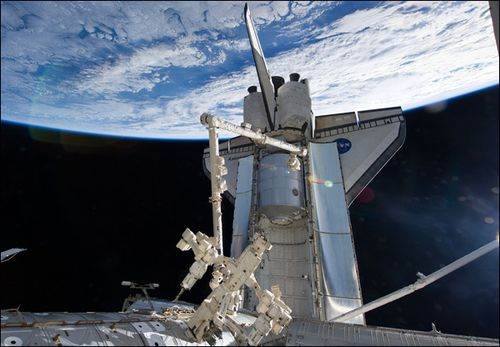The amount of debris hurtling around
in space is reaching alarming quantities and the risk of it falling to Earth
increasing
Back in August a giant Proton rocket failed
to reach its intended orbit and its passengers, a pair of DTH communication
satellites, were lost forever. In mid-October the BRIX-M upper stage of the
rocket exploded. By October 25 the authorities had calculated that the failure
added a worrying 500 pieces of larger space junk, and probably hundreds more
smaller pieces not observable on radar. This new batch of space junk has added
to the thousands of other parts hurtling around our planet and creasing very
real risks for rocket launches, and orbiting satellites such as the
International Space Station (ISS), Hubble Telescope and even GPS and other low
and mid-Earth orbiting craft.

A
NASA diagram of tracked space junk in Low Earth Orbit
By and large geostationary satellites are
immune from these threats given their extremely high orbits, but the risk of celestial
collision is extremely real for the rocket launches that have to penetrate this
‘junk cloud’ immediately after launch and while on their way to GEO orbit.
NASA reckons there are about 21,000 pieces
of space junk in orbit larger than 10cm (4in) across, and many, many more
pieces smaller than 10cm; in fact, NASA says there are “millions” of pieces
smaller than 1cm hurtling around. The danger of one screw or nut or tiny
segment of metal hurtling towards the ISS doesn’t bear thinking about. NASA says
that the ISS has frequently had to fire up its on-board engines in order to
“miss” potential space junk collisions. This uses up precious fuel and
potentially threatens scientific work that might be in progress when an
emergency is declared. The good news is that the threat is detected. The bad
news is that even a small flying missile, can arrive undetected and take off a
Solar Panel, or penetrate the ISS living quarters with devastating results.

This
graph shows altitude and position of space caused by the deliberate destruction
of one of their satellites, measured in km above the Earth, and minutes
following the explosion.
Collision course
The International Space Station travels at
about 414 kilometers (257 miles) above the Earth and its living quarters and
principle technology segments are protected by a thin ‘meteor bumper’ or
Whipple Shield, designed to protect crew and components but not all parts of a
satellite can be protected in this way. The very thin shield works on the basis
that a micro-meteorite (or tiny piece of space junk) would hit the risk to the
actual craft. Solar panels, for example, are especially vulnerable.
Indeed, it isn’t just exploding rockets
that can do the damage. Back in 2007 China deliberately sent a rocket up to
destroy one of its own satellites!
Key to understanding the threat from space
junk is the ‘Kessler syndrome’, a formula that calculates the collision risk in
space (and even between planetary objects). The theory is simple enough: over
time all such parts diminish b falling to Earth or the planet they are orbiting
and burning up. The Donald Kessler work, initially focusing on the threats to
spacecraft by the Asteroid Belt in deep space, suggested that such risks to
damage could be mitigated and predicted. His theory has subsequently been
proven. Kessler’s work, and subsequent expert study, can predict with accuracy
the length of time it takes for these hundreds of pieces from a single impact
to decay and fall to Earth.
This is all well and good but the problem
is – as the October Proton launch proved – as fast as older object are decaying
we are creating new problems. Indeed, some experts now suggest that some parts
of our satellite orbital regions are hugely dangerous. By the end of the 1990s
it was calculated that of some 28,000 piece of largish space junk identified
the majority had decayed and fallen to Earth, leaving around 8,500 in orbit.
That number has been steadily increasing. By 2005 it stood at 13,000 objects.
By 2006 it had leapt to 19,000 objects because of a satellite collision in
space and by last year the number had grown to 22,000 items sufficiently large
to be tracked from Earth. And millions of piece too small to be tracked!
The risks are truly immense. NASA has
calculated that a small part, weighing no more than 1kg travelling at the not
unreasonable speed of 10km/s would have sufficient impact mass to totally
destroy a one tonne satellite. The USA’s National Academy of Sciences now
suggests that two bands are now extremely risky for satellite: the Low Earth
Orbit (LEO) band of 900-1,000kms, and the band around 1,500kms up in space.
As you rise further away from Earth and get
into GEO territory the risks get less, but are more difficult to track. For
example, from Earth we can only ‘measure’ by radar objects that are about one
meter across. And there’s a lot of junk up there still. One set of examples is
Russian RORSAT programmer, which saw satellites sent up in the 1970s and 1980s.
When they reached the end of their useful life most were sent high into a safe,
‘graveyard’ orbit. But some weren’t. And each of these satellites has on board
a risk that one of these will suffer a leak to its coolant reactor and release
its damaging material.
Into orbit
Scripps TV up for sale?
Scripps Networks, best known in the UK as a
50 percent owner of the ‘UKTV’ bouquet of channels, is said to be up for sale.
Scripps bought UK-based Travel Channel Int’l (for $107 million) earlier this
year. On the TV side of the business it has the record-fastest projected sales
growth forecast to 2015, and is among the top 13 US media companies.

MDA
are best known for the CanadArm retrieval crane
MDA can bud for SS/Loral
Canada’s MacDonald, Dettwiler and
associates (MDA) and Space Systems Loral (SS/L) have received anti-trust
approval to proceed with the take-over of SS/Loral by MDA. The $875 million
take-over was announced in June.
DTH increases in Brazil
DTH broadcasting in Brazil continues to
grow rapidly. Subscriber numbers are up more than 3.5 million over the past
year. September’s net growth topped 277,000 new subscribers, according to
Brazil’s National Telecommunications Agency (ANATEL), and taking the nation’s
DTH total (to September 30) to 15.1 million, and representing a 59.5 percentage
share. A year ago the share stood at 52.7 percent.
ITU condemns jamming middle East satellite
jamming has reached what one local broadcaster has described as “catastrophic”
proportions. While Eutelsat and Intelsat have legitimately removed troublesome
Iranian (IRIB) channels from their satellites, the jamming from within Iran and
affecting incoming satellite feeds continues. The BBC, France 24, Deutsche
Welle and the Voice of America are just some of the recently affected channels.
Intelsat drops IRIB
Intelsat has blocked Iran’s official
broadcast channels in Europe. Intelsat declined to confirm or deny an Iranian
report that it did so at the order of the US government. “Intelsat confirms
that we took IRIB (Islamic Republic of Iran Broadcasting) channels off the
satellite, “said Alexander Horwitz, a spokesman for the Washington-based
satellite operator.
Russia’s pay-TV revs up
Russia’s pay-TV market was worth $1136
million during the first nine months of the year, up 18.3 percent year-on-year.
The number of pay TV subscribers increased by 19.6 percent to 29.3 million,
meaning pay TV penetration now stands at 54 percent, up from 46 percent.